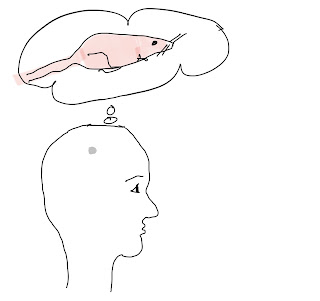Our questions about consciousness
1. Do any animals besides humans have consciousness?
2. What is the extent of animal consciousness? Which species have it?
3. Is animal consciousness different from human consciousness in some really fundamental way?
4. Can animals teach us anything about the mind?
_________________________
What do we mean by "consciousness"?
- Nothing spiritual or "higher"
- "The lights are on"--experience, awareness, there's something it's like
_________________________
Kristin Andrews, The Animal Mind, chapter 4
Three approaches to figuring out whether animals have consciousness
A. Theory Approach
- To have consciousness, or some particular aspect of consciousness, such-and-such requirements must be met (The Theory)
- Kittens do/don't meet those requirements. THEREFORE,
- Kittens have/don't have consciousness.
B. Epistemic Approach
- Kittens have features a, b, c, d, e, f, etc.
- Those features are sufficient to show that kittens do/don't have consciousness. THEREFORE,
- Kittens do/don't have consciousness.
C. Biological Approach (later)
_________________________
Theory Approach (there are lots of theories but we're focussing on two)
- Representational account of perceptual experience (Dretske)--this is a theory of a particular type of consciousness, not all consciousness
- Higher order thought account of perceptual experience (Gennaro--next time)
_________________________
What is Dretske's theory?
What does it tell us about kittens?
Dretske's question: what is it to not just believe the walls are green, but to see them as green? You should find that puzzling because there is nothing green in your head.
Impediments to understanding his answer:
- It's so complicated--there's a lot of termninology: phenomenal, qualia, intentionality, verdical, representation, representational vehicle, content, modes of presentation
- It's so simple
 |
| The greenness of the perceptual experience is explained by the fact that the grey brain blob represents the green property of the wall |
 |
| How does Dretske explain the "pink-ratness" of this experience, considering there's no pink rat to be represented? |
_________________________
What does Dretske's theory tell us about kittens and other animals?
- Conscious perceptual experience involves nothing more than representing properties like colors, sounds, etc. (the theory)
- Kittens can do this kind of representing (why is this obvious?) THEREFORE,
- Kittens have consciousness.
Same goes for fish, birds, octopuses, bees....
Michael Tye (PANIC) and Jesse Prinz (AIR) add on a lot of neurobiological and functional requiements. Why?
_________________________
Next time: a few pages of Andrews plus Rocco Gennaro, "Animal Consciousness and Higher-Order Thoughts"



No comments:
Post a Comment